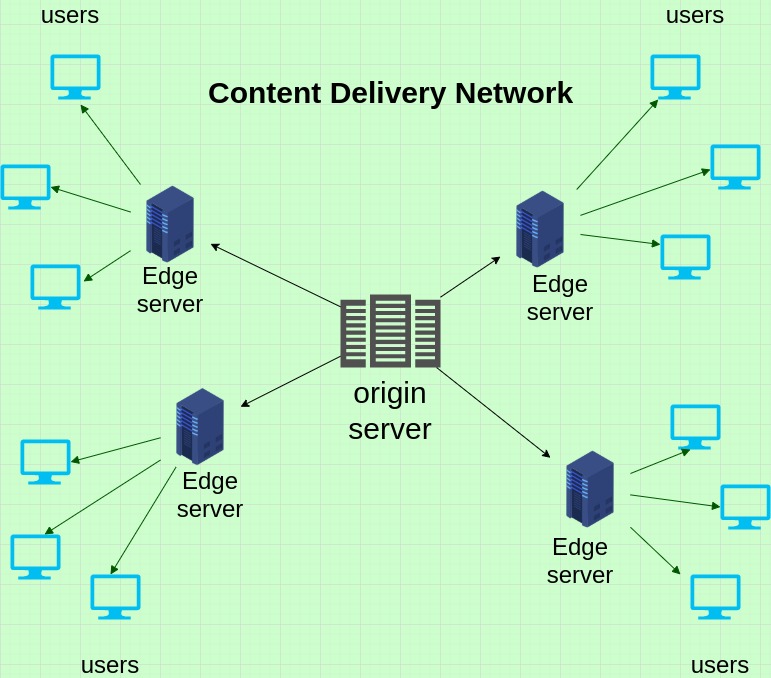Content Delivery Network: Boost Your Website Speed and Security
A Content Delivery Network (CDN) is a system of distributed servers that deliver web content to users based on their geographic location. CDNs improve website performance and reduce latency.
A Content Delivery Network (CDN) is essential for modern websites. It distributes content across multiple servers globally. This ensures faster loading times and a better user experience. CDNs minimize latency by serving data from the nearest server to the user.
This is particularly crucial for high-traffic websites and those with a global audience. Using a CDN can also enhance security by mitigating DDoS attacks. Additionally, it reduces bandwidth costs and improves scalability. Implementing a CDN is a strategic move for any website aiming for optimal performance and reliability.
Introduction To Cdns
In the digital age, fast content delivery is crucial. Users expect quick access to websites. This is where Content Delivery Networks (CDNs) come in. CDNs help deliver content efficiently and swiftly.
What Is A Cdn?
A Content Delivery Network is a group of servers. These servers are distributed globally. They work together to deliver content quickly. CDNs cache your website content on multiple servers.
When a user requests content, the nearest server responds. This reduces latency and speeds up delivery. CDNs improve website performance and user experience.
Importance Of Cdns
CDNs are vital for modern websites. They offer several benefits:
- Speed: Content is delivered faster from nearby servers.
- Reliability: CDNs handle traffic spikes better.
- Security: CDNs provide better protection against attacks.
- SEO: Faster sites rank better on search engines.
CDNs are essential for businesses. They ensure users get the best online experience. Investing in a CDN can boost your website’s performance significantly.

Credit: www.cloudflare.com
How Cdns Work
Understanding how a Content Delivery Network (CDN) works is crucial. CDNs enhance the speed and efficiency of delivering web content. Let’s break down the process into simple parts.
Content Distribution
CDNs distribute content across multiple servers. These servers are located in various parts of the world.
Here is a simple table explaining the distribution process:
| Step | Description |
|---|---|
| 1 | Content is stored on the origin server. |
| 2 | CDN copies the content to multiple servers. |
| 3 | Content is delivered from the nearest server. |
Edge Servers
Edge servers are the key to CDN efficiency. They are located close to the end-users.
Edge servers store cached versions of your content. This reduces the distance data needs to travel.
- Faster loading times
- Lower latency
- Better user experience
CDNs use these edge servers to serve content quickly. This ensures your website loads fast, wherever your users are.
Speed Enhancements
A Content Delivery Network (CDN) brings significant speed enhancements to your website. Speed is crucial for user experience. Faster websites keep users engaged and reduce bounce rates. Let’s explore how a CDN can help improve speed.
Reduced Latency
Reduced latency means faster loading times. CDNs achieve this by distributing content across multiple servers. These servers are located in different geographical locations. When a user requests content, it is delivered from the nearest server. This minimizes the distance data travels, reducing latency.
Latency impacts user experience. Slow websites frustrate users. A CDN ensures your content loads quickly, regardless of where users are located.
Optimized Routing
CDNs use optimized routing to speed up content delivery. They find the fastest path to deliver data. This involves using the best routes and avoiding congested networks.
Optimized routing reduces the time it takes for data to travel. This makes your website faster. Users enjoy a smoother experience. They can access content quickly and efficiently.
| Speed Enhancement | Description |
|---|---|
| Reduced Latency | Delivers content from the nearest server to the user. |
| Optimized Routing | Uses the fastest path to deliver data, avoiding congestion. |
Implementing a CDN brings numerous benefits. Your website will load faster. Users will have a better experience. This can lead to higher engagement and lower bounce rates.

Credit: www.spiceworks.com
Security Benefits
Using a Content Delivery Network (CDN) offers many security benefits. A CDN helps keep your website safe and secure. This section explains some key security benefits of using a CDN.
Ddos Protection
DDoS attacks can overwhelm your website with fake traffic. This can make your site slow or even crash. A CDN can help protect against these attacks. It does this by distributing the traffic across many servers. This makes it harder for attackers to target your website.
Here are some ways CDNs provide DDoS protection:
- Traffic Filtering: Identifies and blocks bad traffic.
- Load Balancing: Spreads traffic across multiple servers.
- Rate Limiting: Controls the number of requests from one source.
Secure Data Transfer
Secure data transfer is essential for any website. A CDN helps protect your data as it travels across the internet. It uses encryption to keep data safe from hackers. This ensures your users’ information stays private.
Key features of secure data transfer include:
| Feature | Description |
|---|---|
| Encryption | Keeps data safe during transfer. |
| SSL/TLS | Ensures data is encrypted end-to-end. |
| Authentication | Verifies the identity of users and servers. |
Using a CDN for your website offers many security benefits. It protects against DDoS attacks and ensures secure data transfer. This helps keep your website safe and your users’ data secure.
Key Cdn Features
Content Delivery Networks (CDNs) have transformed how we access online content. They ensure faster and more reliable delivery of web pages, videos, and other digital assets. Below are some key features that make CDNs indispensable for modern web applications.
Caching
Caching is a fundamental feature of CDNs. It stores copies of your files in multiple locations globally. This reduces latency and speeds up load times. Instead of fetching data from the origin server, users get it from the nearest cache.
CDNs use various caching strategies:
- Time-to-Live (TTL): Defines how long a file stays in the cache.
- Cache Purge: Allows instant removal of outdated content.
- Stale-While-Revalidate: Serves stale content while fetching a fresh copy.
By optimizing caching, CDNs improve user experience and reduce server load.
Load Balancing
Load balancing distributes incoming traffic across multiple servers. This ensures no single server gets overwhelmed. CDNs use various algorithms to manage this:
- Round Robin: Distributes requests sequentially among servers.
- Least Connections: Directs traffic to the server with the fewest connections.
- IP Hash: Routes requests based on client IP addresses.
Load balancing enhances reliability and uptime. It also helps in handling traffic spikes efficiently. This feature is crucial for websites with high traffic volumes.
Understanding these key features can help you make the most of your CDN. They ensure faster, more reliable, and secure content delivery.

Credit: cloudkul.com
Choosing A Cdn Provider
Choosing the right Content Delivery Network (CDN) provider is crucial. It impacts the performance and reliability of your website. This section will help you identify key factors and popular CDN providers.
Factors To Consider
- Performance: Look for a CDN with a broad network. It should have servers close to your audience.
- Security: Ensure the CDN offers robust security features. These include DDoS protection and SSL certificates.
- Scalability: Choose a CDN that can grow with your needs. It should handle traffic spikes efficiently.
- Cost: Consider your budget. Compare pricing models and features.
- Support: Opt for a provider with excellent customer support. This ensures quick resolution of issues.
- Ease of Integration: The CDN should be easy to set up. It should work well with your existing infrastructure.
Popular Cdn Providers
| Provider | Key Features |
|---|---|
| Cloudflare |
|
| Amazon CloudFront |
|
| Akamai |
|
| Fastly |
|
Implementing A Cdn
Implementing a Content Delivery Network (CDN) can significantly enhance your website’s speed. A CDN reduces latency and boosts performance. This section will guide you through the steps to integrate a CDN and best practices to follow.
Integration Steps
Follow these steps to integrate a CDN into your website:
- Choose a CDN provider that suits your needs.
- Create an account and set up your CDN profile.
- Add your website’s domain to the CDN dashboard.
- Update your DNS settings to point to the CDN.
- Configure your CDN settings to optimize performance.
- Test your website to ensure it’s working correctly.
Best Practices
Adhering to these best practices will maximize the benefits of your CDN:
- Minimize your file sizes by compressing images and code.
- Enable browser caching to speed up repeat visits.
- Use SSL/TLS to secure your content and enhance trust.
- Monitor your CDN performance with analytics tools.
- Regularly update your CDN settings for optimal performance.
| Best Practice | Description |
|---|---|
| Minimize File Sizes | Compress images and code to reduce load times. |
| Enable Browser Caching | Speed up repeat visits by storing data locally. |
| Use SSL/TLS | Secure your content and enhance user trust. |
| Monitor Performance | Use analytics tools to track CDN performance. |
| Regular Updates | Keep your CDN settings optimized and up-to-date. |
Case Studies
Content Delivery Networks (CDNs) have transformed how online content is delivered. Understanding their impact through case studies provides valuable insights. This section explores real-world examples of CDN implementations, highlighting successes and lessons learned.
Successful Implementations
Many companies have experienced significant improvements after implementing CDNs. Below are some notable cases:
| Company | Challenge | Result |
|---|---|---|
| Netflix | High demand for streaming | Reduced buffering, improved user experience |
| Amazon | Global reach | Faster load times, increased sales |
| BBC | Broadcasting live events | Seamless streaming, higher viewer satisfaction |
Lessons Learned
Implementing a CDN can be challenging. Here are key lessons from successful deployments:
- Understand your audience: Know where most users are located.
- Test extensively: Test the CDN in various conditions.
- Monitor performance: Use analytics tools to track improvements.
- Optimize content: Compress images and files for faster delivery.
- Stay updated: Keep up with CDN technology advancements.
These lessons can guide you in making the most of CDN technology.
Future Of Cdns
The future of Content Delivery Networks (CDNs) looks bright. CDNs are evolving rapidly to meet growing demands. They ensure faster content delivery across the globe. Let’s explore the emerging trends and technological advancements shaping the future of CDNs.
Emerging Trends
Edge Computing is gaining popularity. It brings data processing closer to users. This reduces latency and improves performance. Multi-CDN Strategies are also on the rise. They use multiple CDNs to enhance reliability and speed. AI and Machine Learning are being integrated into CDNs. They help in optimizing content delivery.
- Edge Computing: Reduces latency, improves performance.
- Multi-CDN Strategies: Enhances reliability and speed.
- AI and Machine Learning: Optimizes content delivery.
Technological Advancements
5G Technology is set to revolutionize CDNs. It will enable faster data transfer speeds. Blockchain Technology is being explored for its security benefits. It can provide a tamper-proof record of content transactions. Serverless Computing is another advancement. It allows developers to run code without managing servers.
| Technology | Benefit |
|---|---|
| 5G Technology | Faster data transfer speeds. |
| Blockchain Technology | Enhanced security and transparency. |
| Serverless Computing | Run code without managing servers. |
Frequently Asked Questions
What Is The Purpose Of A Cdn?
A CDN, or Content Delivery Network, speeds up website loading times by distributing content across multiple servers worldwide. This enhances user experience and reduces latency.
What Is The Difference Between Dns And Cdn?
DNS translates domain names to IP addresses. CDN distributes web content across multiple servers to reduce load times and improve performance.
What Is The Difference Between Isp And Cdn?
An ISP provides internet access to users. A CDN delivers content quickly by distributing it across multiple servers.
What Is The Difference Between Cms And Cdn?
A CMS manages and creates digital content, while a CDN delivers that content quickly to users by caching it on multiple servers globally.
Conclusion
Embracing a Content Delivery Network can significantly improve your website’s performance. Faster loading times lead to better user experience. Enhanced security features protect your data. With a CDN, you can reach a global audience effortlessly. Implementing a CDN is a strategic move for any online business aiming for growth.




